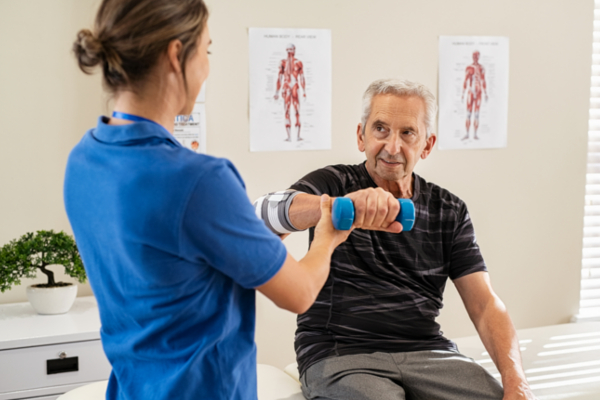
Osteoporosis occurs when the bones lose density and strength with age, due to a gradual change in structure. Its presence increases risk of fracture and can influence quality of life through pain and physical limitations.
Although postmenopausal women are more likely to develop osteoporosis, the condition characterized by thinner, more porous bone structure can affect individuals at any age. External factors and preexisting conditions can also influence or accelerate its development. As a result, patients with osteoporosis are more likely to be hospitalized for bone fractures.
Considering these factors, it’s falsely believed that those affected by the condition need to limit physical activity to prevent a bone fracture or break. Yet the right kind of activity can help strengthen muscles, which provides better protection for the bones.
Benefits of Exercise for Bone Strength
In general, exercise has a positive impact on our bones, regardless of whether or not you have osteoporosis.
To help manage this condition, exercise can:
- Improve balance
- Increase muscle strength
- Provide better bone support
- Help improve posture
- Increase range of motion
- Help decrease pain
Yet individuals with osteoporosis do need to be more careful. A physical therapist can prescribe and guide you through the following routines:
- Strength training, especially for the upper back
- Weight-bearing aerobic exercises
- Flexibility exercises
- Exercises focusing on stability and balance
Due to fracture and fall risks, exercises involving twisting, bending and endurance should be avoided. For those who already experienced a fracture, a physical therapist can work with you to:
- Lessen pain through posture and positioning exercises
- Find supportive devices to help improve healing and posture
- Decrease fall risks through exercises that strengthen muscles, improve balance and posture
Physical Therapy to Manage Osteoporosis
Patients are diagnosed with osteoporosis after a bone density test or fitness assessment. Results that indicate decreased or low bone density help determine your long-term treatment plan, which may include physical therapy.
To manage osteoporosis, sessions with a physical therapist have a two-fold benefit. One, exercises help strengthen muscles and lessen the progress of bone loss. Two, for patients already experiencing decreased quality of life, targeted exercises can lower dependence on prescription pain medications.
Working with a physical therapist, a treatment plan will be developed to address:
- Postural improvements to decrease potential spine fractures
- Improving bodily alignment for everyday activities
- Improving balance to lessen potential fall risks
- Adjusting your home environment to help decrease fall risks
- Decreasing fracture risks through everyday actions, including how you work and sleep
For those who already experienced a fracture, your plan may also target decreasing the pattern of bone loss for the hips, shoulders, spine and arms. Treatment plans further take into account the progression of bone loss, your current health and fitness level, age and how these factors affect future fracture risks.
Although plans are personalized, patients looking to decrease osteoporosis risks or manage the condition may be directed to a combination of the following.
Weight-Bearing Exercises
Weight-bearing exercises involve standing up to have your bones support your weight. These routines strengthen the bones in your lower half, while engaging your cardiovascular and circulatory systems.
Common exercises include dancing, jogging, heel drops and stomping.
Aerobic Exercises
For patients with osteoporosis, aerobic exercises help improve the spinal curve and reduce fracture risks. Excluding weight-bearing exercises, common routines include walking, using an elliptical machine, swimming and running.
Resistance Training
Resistance training or light weightlifting directly targets the muscles and helps strengthen joints – factors that can improve balance, posture, bone density and decrease fall risks. Routines can target the hips and spine and generally start with a low level of resistance that you will increase over time.
Aside from weightlifting, other forms of resistance training include the use of exercise bands, push-ups, squats, lunges and select yoga poses.
Stability and Balance Exercises
Although resistance training focuses on improving your stability and balance, a physical therapist may steer you toward routines to increase strength and decrease fall risks. Common exercises include standing on one leg, tai chi and select yoga poses.
If you’ve been diagnosed with low bone density or osteoporosis and your doctor has recommended a physical therapy plan, turn to Integrated Rehab. To get started, contact us today.

